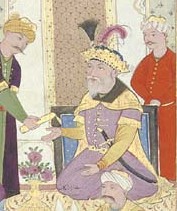Sultan Murad (Aq Qoyunlu)
| Sultan Murad | |
|---|---|
 The envoy Qanbar Aqa, sent by Shah Ismail I, before Sultan Murad. Made by Mo'en Mosavver, Isfahan, c. 1670 | |
| Sultan of the Aq Qoyunlu | |
| Reign | 1497–1508 |
| Predecessor | Ahmad Beg |
| Successor | Ismail I (Safavid Iran) |
| Born | 1483 |
| Died | 1514 (aged 24) Ruha, Diyar Bakr |
| Spouse | Beglu Khatun |
| Issue | Hasan Ya'qub Jan Agha Khanum |
| Father | Ya'qub Beg |
| Mother | Gawhar-Sultan Khanum |
| Religion | Sunni Islam |
Sultan Murad (also spelled Sultan-Murad) (persian: سلطان مراد) was the last sultan of the Aq Qoyunlu from 1497 to 1508. After losing his kingdom to the Safavid Shah Ismail I (r. 1501–1524), he fled to Diyar Bakr, where he was eventually killed by Shah Ismail's Qizilbash soldiers at the end of 1514.
Reign
Civil war in the Aq Qoyunlu realm
Born in 1483, he was a son of
In the spring of 1498, while Ayba-Sultan was on his way to the capital
War with Shah Ismail I
In the winter of 1502 or 1503, the Safavid Shah Ismail I (r. 1501–1524) contacted Sultan Murad, who was in control over Fars and Persian Iraq, albeit mostly nominally. In reality, his governors ruled freely. The provinces were in disarray due to ceaseless war, famine, plague, and oppression by the Aq Qoyunlu dignitaries. Ismail reminded Sultan Murad of the common lineage that the Safavids and Aq Qoyunlu shared, and offered him part of Persian Iraq in exchange for compliance, or war would occur.[6]
Although some of Murad's men advocated peace, the latter marched towards Ismail (whose army totalled 12,000) at head of 70,000 men, but was defeated near the city of
Offspring
Sultan Murad was survived by several of his offsprings. He had two sons with the daughter of Ala al-Dawla Bozkurt, Beglu Khatun: Hasan and Ya'qub, but nothing is known about them.[9] He also had a daughter, Jan Agha Khanum, who would eventually marry the Safavid governor-general of Khorasan and guardian of the Safavid prince Abbas, Ali-Qoli Khan Shamlu (died 1589).[8]
References
- ^ Woods 1999, pp. 149–150, 270 (note 32).
- ^ Woods 1999, pp. 158–159.
- ^ Woods 1999, p. 159.
- ^ Woods 1999, pp. 160–161.
- ^ Woods 1999, p. 161.
- ^ a b Savory 1965, pp. 71–72.
- ^ Savory 1965, pp. 72–73.
- ^ a b c Woods 1999, p. 166.
- ^ Venzke 2017.
Sources
- Quiring-Zoche, R. (1986). "Āq Qoyunlū". Encyclopædia Iranica, online edition, Vol. II, Fasc. 2. New York. pp. 163–168.
{{cite encyclopedia}}: CS1 maint: location missing publisher (link) - Savory, Roger M. (1965). "The Consolidation of Safawid power in Persia". Jahresband. 40. De Gruyter: 71–94. S2CID 161679360.
- ISBN 978-0874805659.
- Venzke, Margaret L. (2017). "Dulkadir". In Fleet, Kate; Krämer, Gudrun; Matringe, Denis; Nawas, John; Stewart, Denis J. (eds.). Encyclopaedia of Islam. Vol. III. E. J. Brill.
